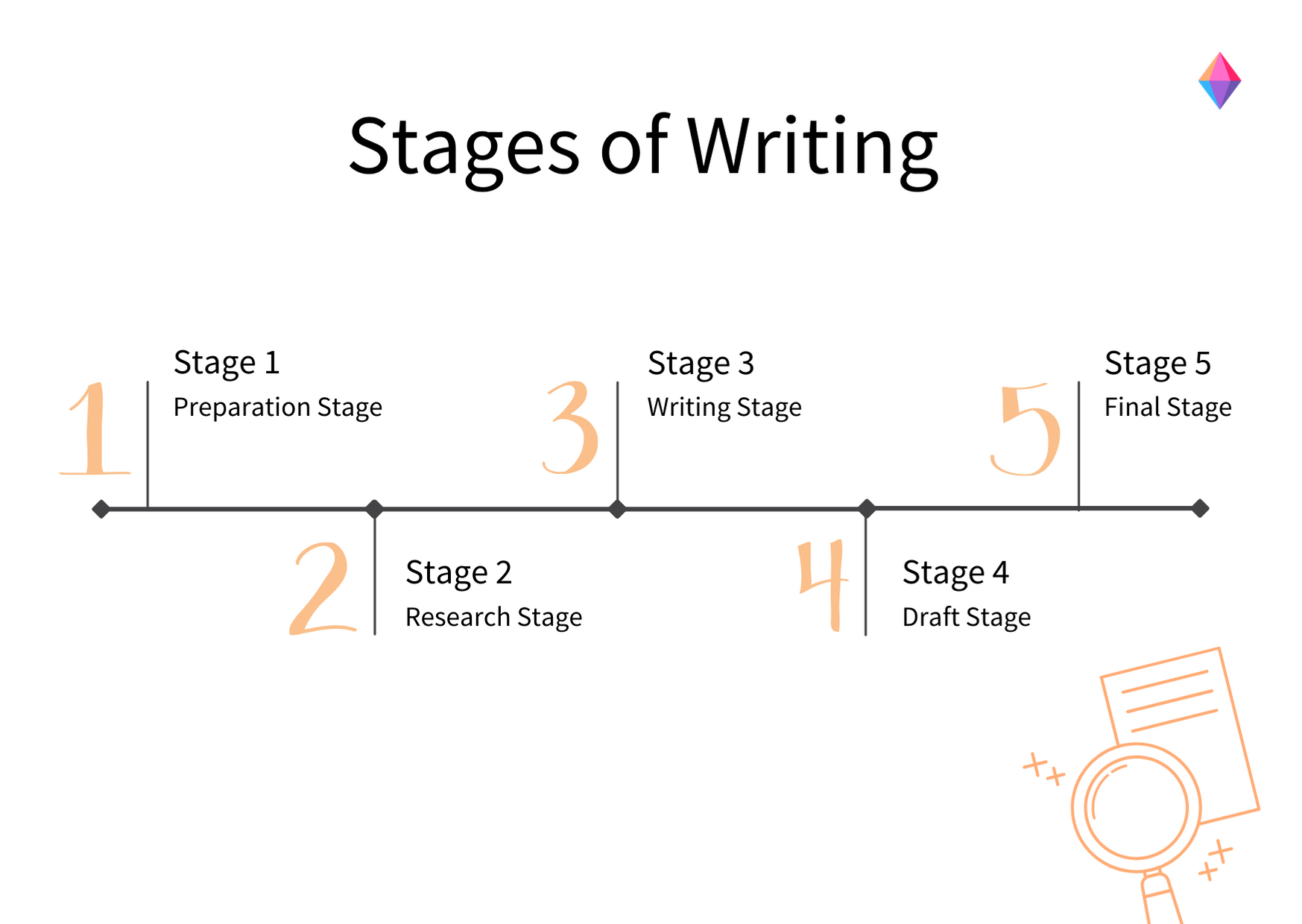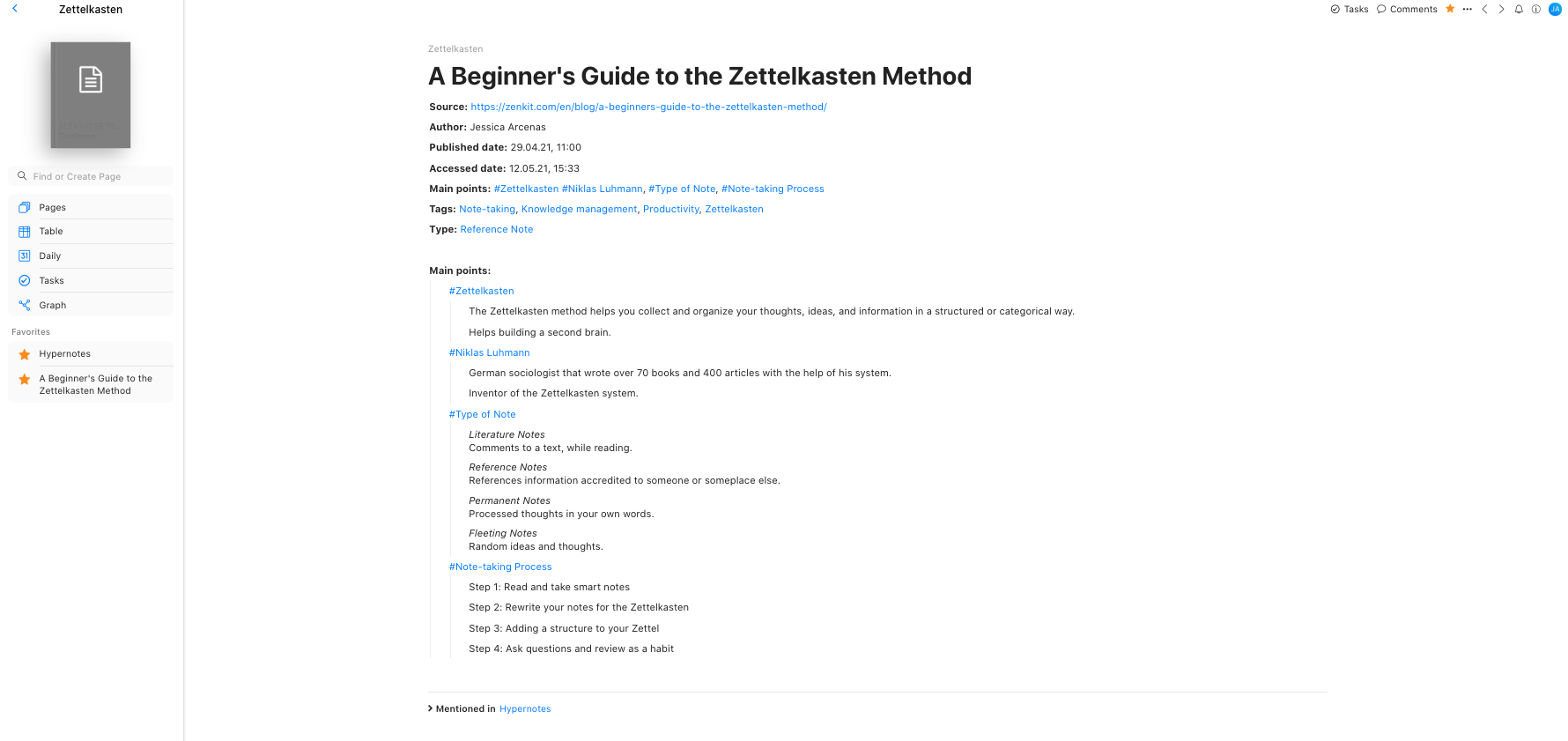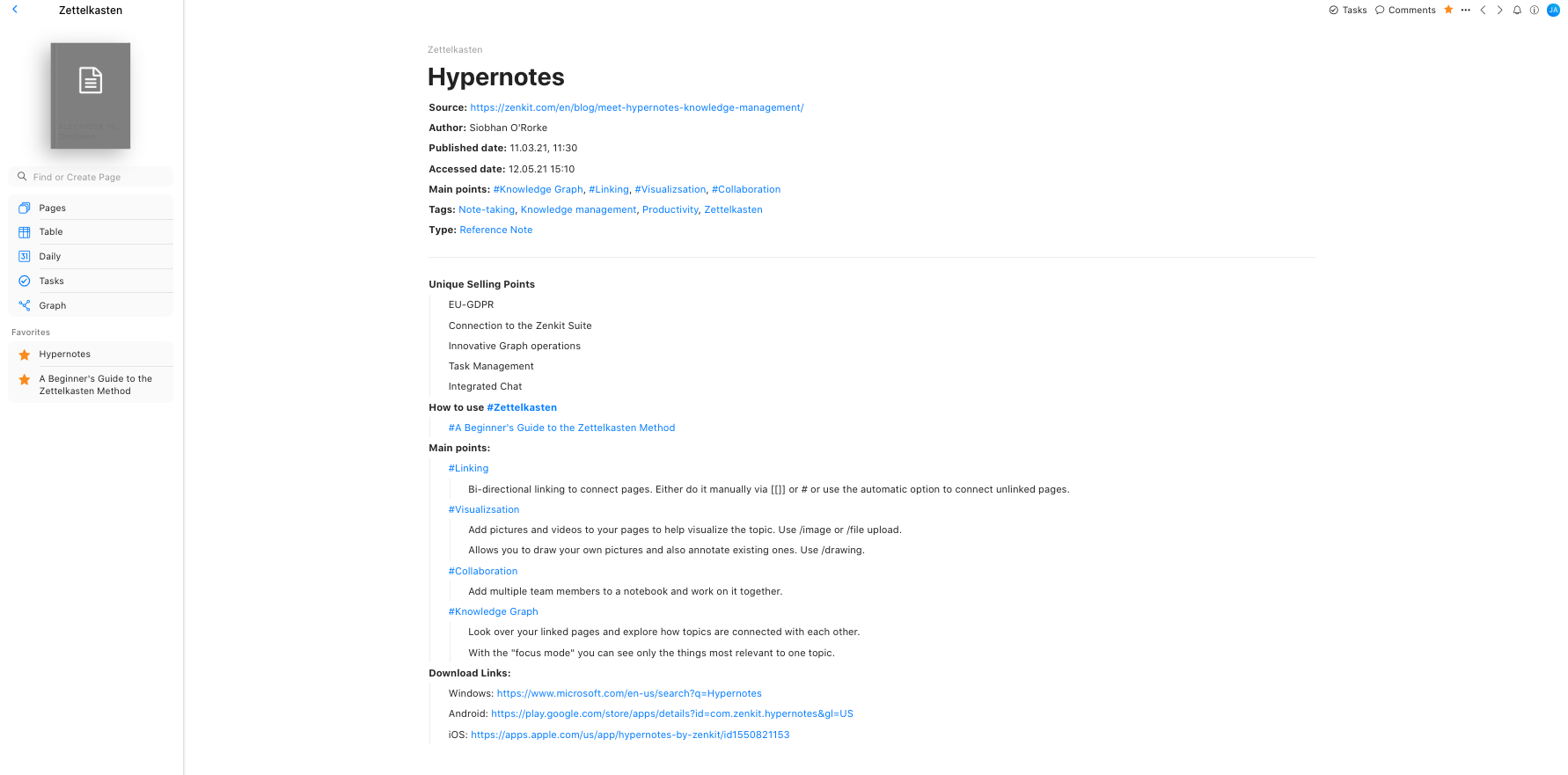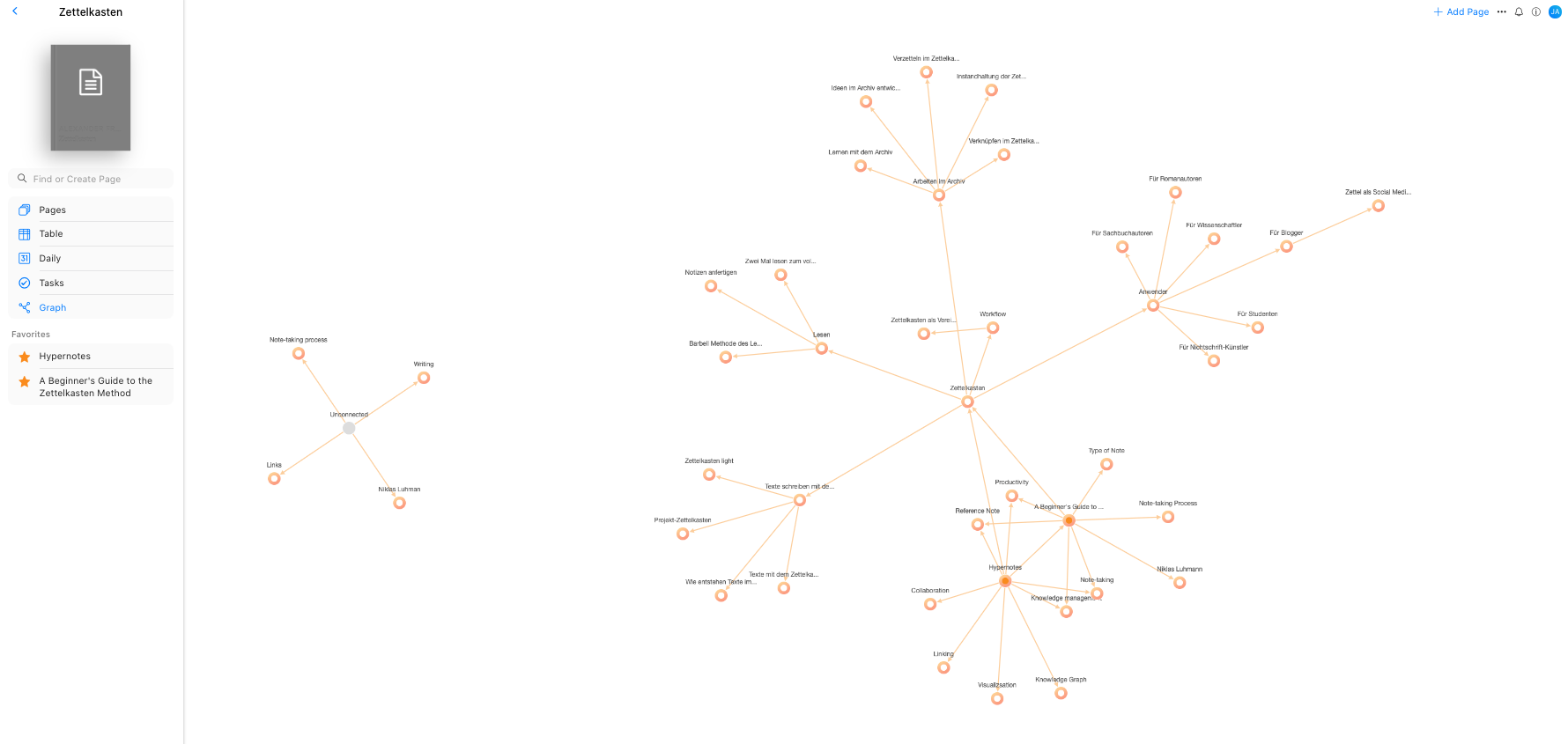Smart Note-Taking for Research Paper Writing
How to organize research notes using the Zettelkasten Method when writing academic papers

With plenty of note-taking tips and apps available, online and in paper form, it’s become extremely easy to take note of information, ideas, or thoughts. As simple as it is to write down an idea or jot down a quote, the skill of academic research and writing for a thesis paper is on another level entirely. And keeping a record or an archive of all of the information you need can quickly require a very organized system.

The use of index cards seems old-fashioned considering that note-taking apps (psst! Hypernotes) offer better functionality and are arguably more user-friendly. However, software is only there to help aid our individual workflow and thinking process. That’s why understanding and learning how to properly research, take notes and write academic papers is still a highly valuable skill.
Let’s Start Writing! But Where to Start…
Writing academic papers is a vital skill most students need to learn and practice. Academic papers are usually time-intensive pieces of written content that are a requirement throughout school or at University. Whether a topic is assigned or you have to choose your own, there’s little room for variation in how to begin.
Popular and purposeful in analyzing and evaluating the knowledge of the author as well as assessing if the learning objectives were met, research papers serve as information-packed content. Most of us may not end up working jobs in academic professions or be researchers at institutions, where writing research papers is also part of the job, but we often read such papers.
Despite the fact that most research papers or dissertations aren’t often read in full, journalists, academics, and other professionals regularly use academic papers as a basis for further literary publications or blog articles. The standard of academic papers ensures the validity of the information and gives the content authority.
There’s no-nonsense in research papers. To make sure to write convincing and correct content, the research stage is extremely important. And, naturally, when doing any kind of research, we take notes.
Why Take Notes?
There are particular standards defined for writing academic papers. In order to meet these standards, a specific amount of background information and researched literature is required. Taking notes helps keep track of read/consumed literary material as well as keeps a file of any information that may be of importance to the topic.
The aim of writing isn’t merely to advertise fully formed opinions, but also serves the purpose of developing opinions worth sharing in the first place.
What is Note-Taking?

Note-taking (sometimes written as notetaking or note-taking) is the practice of recording information from different sources and platforms. For academic writing, note-taking is the process of obtaining and compiling information that answers and supports the research paper’s questions and topic. Notes can be in one of three forms: summary, paraphrase, or direct quotation.
Note-taking is an excellent process useful for anyone to turn individual thoughts and information into organized ideas ready to be communicated through writing. Notes are, however, only as valuable as the context. Since notes are also a byproduct of the information we consume daily, it’s important to categorize information, develop connections, and establish relationships between pieces of information.
What Type of Notes Can I Take?
- Explanation of complex theories
- Background information on events or persons of interest
- Definitions of terms
- Quotations of significant value
- Illustrations or graphics
Note-Taking 101

Taking notes or doing research for academic papers shouldn’t be that difficult, considering we take notes all the time. Wrong. Note-taking for research papers isn’t the same as quickly noting down an interesting slogan or cool quote from a video, putting it on a sticky note, and slapping it onto your bedroom or office wall.
Note-taking for research papers requires focus and careful deliberation of which information is important to note down, keep on file, or use and reference in your own writing. Depending on the topic and requirements of your research paper from your University or institution, your notes might include explanations of complex theories, definitions, quotations, and graphics.
Stages of Research Paper Writing

1. Preparation Stage
Before you start, it’s recommended to draft a plan or an outline of how you wish to begin preparing to write your research paper. Make note of the topic you will be writing on, as well as the stylistic and literary requirements for your paper.
2. Research Stage
In the research stage, finding good and useful literary material for background knowledge is vital. To find particular publications on a topic, you can use Google Scholar or access literary databases and institutions made available to you through your school, university, or institution.
Make sure to write down the source location of the literary material you find. Always include the reference title, author, page number, and source destination. This saves you time when formatting your paper in the later stages and helps keep the information you collect organized and referenceable.

In the worst-case scenario, you’ll have to do a backward search to find the source of a quote you wrote down without reference to the original literary material.
3. Writing Stage
When writing, an outline or paper structure is helpful to visually break up the piece into sections. Once you have defined the sections, you can begin writing and referencing the information you have collected in the research stage.
Clearly mark which text pieces and information where you relied on background knowledge, which texts are directly sourced, and which information you summarized or have written in your own words. This is where your paper starts to take shape.
4. Draft Stage
After organizing all of your collected notes and starting to write your paper, you are already in the draft stage. In the draft stage, the background information collected and the text written in your own words come together. Every piece of information is structured by the subtopics and sections you defined in the previous stages.
5. Final Stage
Success! Well… almost! In the final stage, you look over your whole paper and check for consistency and any irrelevancies. Read through the entire paper for clarity, grammatical errors, and peace of mind that you have included everything important.
Make sure you use the correct formatting and referencing method requested by your University or institution for research papers. Don’t forget to save it and then send the paper on its way.
Best Practice Note-Taking Tips
- Find relevant and authoritative literary material through the search bar of literary databases and institutions.
- Practice citation repeatedly! Always keep a record of the reference book title, author, page number, and source location. At best, format the citation in the necessary format from the beginning.
- Organize your notes according to topic or reference to easily find the information again when in the writing stage. Work invested in the early stages eases the writing and editing process of the later stages.
- Summarize research notes and write in your own words as much as possible. Cite direct quotes and clearly mark copied text in your notes to avoid plagiarism.
Take Smart Notes

Taking smart notes isn’t as difficult as it seems. It’s simply a matter of principle, defined structure, and consistency. Whether you opt for a paper-based system or use a digital tool to write and organize your notes depends solely on your individual personality, needs, and workflow.
With various productivity apps promoting diverse techniques, a good note-taking system to take smart notes is the Zettelkasten Method. Invented by Niklas Luhmann, a german sociologist and researcher, the Zettelkasten Method is known as the smart note-taking method that popularized personalized knowledge management.
As a strategic process for thinking and writing, the Zettelkasten Method helps you organize your knowledge while working, studying, or researching. Directly translated as a ‘note box’, Zettelkasten is simply a framework to help organize your ideas, thoughts, and information by relating pieces of knowledge and connecting pieces of information to each other.
Hypernotes is a note-taking app that can be used as a software-based Zettelkasten, with integrated features to make smart note-taking so much easier, such as auto-connecting related notes, and syncing to multiple devices. In each notebook, you can create an archive of your thoughts, ideas, and information.

Using the tag system to connect like-minded ideas and information to one another and letting Hypernotes do its thing with bi-directional linking, you’ll soon create a web of knowledge about anything you’ve ever taken note of. This feature is extremely helpful to navigate through the enormous amounts of information you’ve written down. Another benefit is that it assists you in categorizing and making connections between your ideas, thoughts, and saved information in a single notebook. Navigate through your notes, ideas, and knowledge easily.
Ready, Set, Go!
Writing academic papers is no simple task. Depending on the requirements, resources available, and your personal research and writing style, techniques, apps, or practice help keep you organized and increase your productivity.
Whether you use a particular note-taking app like Hypernotes for your research paper writing or opt for a paper-based system, make sure you follow a particular structure. Repeat the steps that help you find the information you need quicker and allow you to reproduce or create knowledge naturally.
Images from NeONBRAND , hana_k and Surface via Unsplash
A well-written piece is made up of authoritative sources and uses the art of connecting ideas, thoughts, and information together. Good luck to all students and professionals working on research paper writing! We hope these tips help you in organizing the information and aid your workflow in your writing process.
Cheers,
Jessica and the Zenkit Team
FREE 20 MIN. CONSULTATION WITH A PROJECT MANAGEMENT EXPERT
Wanna see how to simplify your workflow with Zenkit in less than a day?
Book a Live Demo
Thanks for sending really an exquisite text.
Great article thank you for sharing!